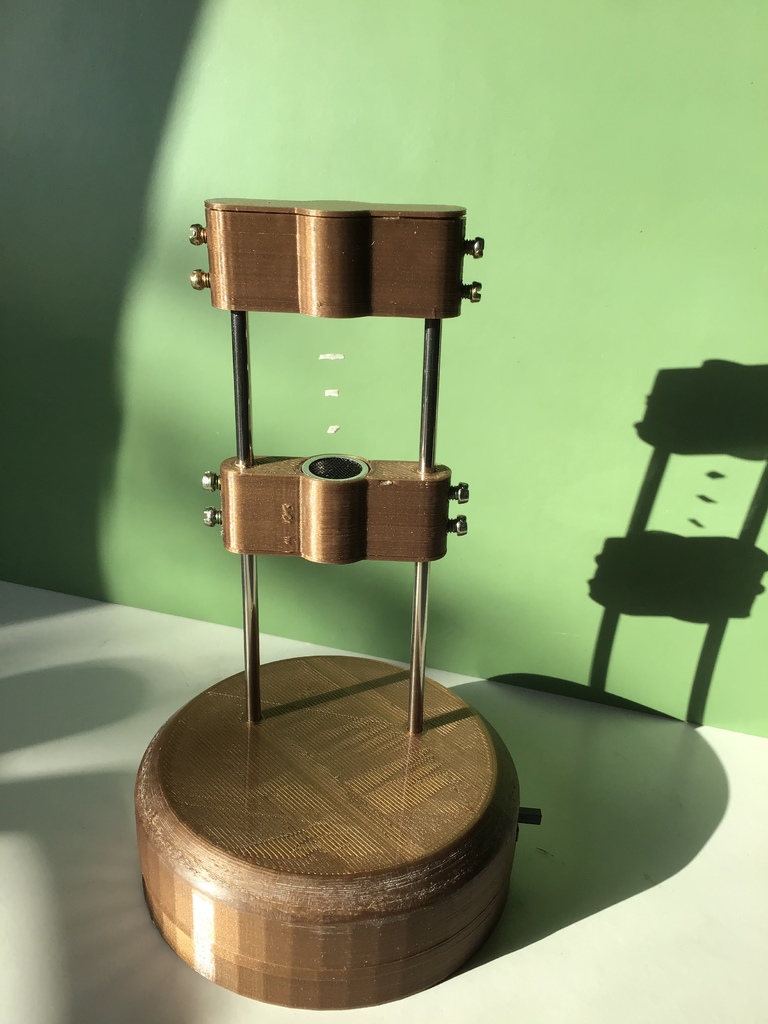
Ultrasonic Levitator
thingiverse
The early version depicted in pictures has undergone significant revisions, as evident from the redrawn design. This levitator functions by generating nodes within the air using a 40 kilohertz standing wave. It's well-established that sound waves consist of moving pressure/compression and rarefaction. The device at hand employs two transmitters, positioned at an exact distance apart to ensure the summation of waves. The nodes are created at the null point of the wave, where it appears possible to levitate or float small pieces of polystyrene. My version of the ultrasonic levitator drew inspiration from a fun project featured on Makezine (https://makezine.com/projects/micro-ultrasonic-levitator/). I'm grateful to the author for sharing their work. One aspect that caught my attention was that this device could have been built approximately 40 years ago, albeit without the microcontroller, by utilizing a simple circuit to generate a 40kHz square wave. I've designed this simplified circuit and 3D-printed frame for several reasons. I hope it's evident that this is not merely a rehashing of existing designs. 1. To significantly reduce power consumption and utilize a PP3 battery. 2. To facilitate a simple calibration method using only a multimeter to adjust frequency. Having a variable oscillator allows you to set the exact peak power output from the transducers, which have a tolerance of +/-1kHz and a very narrow bandwidth. 3. To enable simple calibration using a multimeter again to adjust the phase or standing wave ratio. Ultrasonic levitator assembly The circuit can be easily constructed using the custom PCB I've provided as an A4 pdf, if you're inclined to create your own PCBs. I've created mine using toner transfer and etching with ferric chloride. Alternatively, you could use strip board; see the picture for guidance. All components are inexpensive and readily available. The mechanical adjustment and signal feed are facilitated using conductors from 15 amp choc block. I soldered conductors to the back by fixing them to a 4mm wood dowel, cleaning with fine wire wool, and then soldering directly. See the picture for details. Fit the metal rods into the base and a transducer housing onto the top of the rods to achieve parallel spacing. Secure the transducers and contacts using hot melt glue or two-part epoxy (which takes longer). Ultrasonic levitator adjustment (See the film) When correctly tuned, the levitator will consume approximately 30-40 milliamperes, which should provide at least 10 hours of operation time from a standard PP3 battery. The quiescent current of the circuit is around 4 milliamperes. To tune the levitator circuit, you'll need: 1. A multimeter capable of reading millivolts with clip-type probes. 2. A small screwdriver or pot adjustment tool (tweaker). Place the meter across the shunt resistor R2 on the side of the PCB and connect the ultrasonic transducers and battery. R2 is solely for making this measurement without disrupting the supply circuit, and it can be done at any time. For optimal results, place a rag or cloth between the transducers. Turn on the circuit and adjust the pot VR for maximum current (the pot has more range than I'd like, but this was necessary to allow for a broad frequency range produced by different manufacturers of the CD4093; I used Phillips and Fairchild). You're reading millivolts on the meter, but the millivolts correspond to milliamperes through the resistor. At peak, it should read approximately 40 milliamperes, but 30-40 is reasonable. You may see smaller harmonic peaks, but keep going until you reach the above value. Remove the rag and slide the bottom transducer up and down; you should see slight peaks and troughs in the current. Set the current for the minimum value with the transducers around 30 millimeters apart. Each peak will be just over 8mm from the last, corresponding to the wavelength of the 40kHz sound wave in air. Secure the screws, and it's adjusted. If you set the distance closer to approximately 20mm, you'll find that you can tip the levitator on its side and maintain the levitated object in place. This demonstrates that the pressure applied by the antinodes is on both the top and bottom of the object – sound tweezers! (https://youtu.be/qmqra95md7s)
With this file you will be able to print Ultrasonic Levitator with your 3D printer. Click on the button and save the file on your computer to work, edit or customize your design. You can also find more 3D designs for printers on Ultrasonic Levitator.
